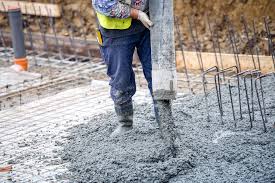
Water is one of a basic trio of components that make up concrete. Adding just the right amount to any mix will determine the strength, consistency and workability of the concrete. Water causes the aggregate and cement to hydrate and gain strength. Too much water, however, and the strength of the mixture will be compromised. When you are asking concrete to do an important structural job, this can be a serious issue. At best it could end up costing you money to rectify a materials problem, at worst it could threaten the structural integrity of your build.
There’s no greater source of unwanted water than a sudden rainstorm. Heavy downpours can cause havoc. Not only will it potentially mess with the consistency of your concrete, but it will also ruin the appearance of the finished surface. Once the damage is done it can be very difficult to put right.
Rain damage
If significant rain falls on freshly poured concrete it can lead to a range of problems. It can cause a new concrete surface to grow soft and this, in turn, decreases the abrasion resistance and the strength of the concrete. It can also increase the likelihood of dusting and cracking taking place.
Other problems that can occur
Not only can rain cause serious issues for newly poured concrete, it can also have a detrimental effect on your preparations. If rain is allowed to oversaturate the subgrade resulting in ponding, it can then find its way into the newly poured concrete, changing the concrete-water ratio.
Unless the weather is unusually dry, you should always cover the ground with plastic sheeting to reduce the risk of it becoming saturated.
What to do when it rains
Despite the best efforts of meteorologists and the most sophisticated weather apps, sometimes rain catches us by surprise. Sudden heavy downpours can happen at any time of year. These are more common at sometimes of the year and in different parts of the country. In the North West, we are in one of the wetter regions of the country, so it’s important to be aware of what to do if you find your concrete pour blighted by sudden heavy rain.
If rain is forecast, you should postpone any significant concrete pour until you’re completely confident that conditions have improved. Even if no rain is predicted you should always prepare for it. Make sure you are ready with a large enough tarpaulin or plastic sheeting to cover the concrete if necessary. After you have placed the cover over the concrete, make sure that you seal the edges so that rainwater is unable to seep underneath.
Here are a few steps you can also take to reduce the damage done to your concrete mix by a sudden downpour:
● Don’t be tempted to begin working the rainwater into the concrete. This is a serious mistake with potentially huge problems.
● Don’t begin to add dry cement to the concrete in the hope that this will soak up the excess water. This will negatively impact on the finish and weaken the top layer of concrete.
● Once the rain has passed, use something to gently push any excess water off the top of the concrete.
How long might it take for concrete to dry in the rain?
If you’ve had time to complete the finishing process and the concrete has stiffened considerably, perhaps after 4-8 hours, the rainwater may have very little impact. Once concrete sets, water aids its hydration and curing. A simple scratch test with a screwdriver can test the integrity of the concrete surface to determine if the rain had any impact.
The experienced team at Goodmix Concrete can advise about the best way to prepare your site for concrete and how to combat the weather.
